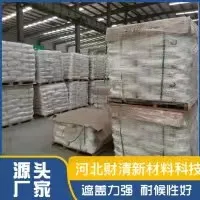
ก.ย. . 01, 2025 10:02 กลับไปที่รายการ
The Role Of Rutile Titanium Dioxide In the Paint And Coating Industry
Titanium dioxide (TiO₂) is one of the most widely used white pigments in the world, renowned for its exceptional opacity, brightness, and UV resistance. It exists in three primary crystalline forms: rutile, anatase, and brookite. Among these, rutile titanium dioxide is the most stable and widely utilized in industrial applications, particularly in the paint and coating sector. Compared to anatase titanium dioxide, the rutile form offers superior durability, higher refractive index, and better resistance to chalking and weathering, making it the preferred choice for high-performance coatings.

The rutile titanium dioxide pigment dominates the market due to its ability to provide excellent coverage, whiteness, and long-term stability. As the demand for high-quality paints and coatings grows, understanding the properties, applications, and rutile titanium dioxide price trends becomes crucial for manufacturers and end-users alike.
Why Rutile Titanium Dioxide is Preferred in Paints and Coatings
Superior Opacity and Light-Scattering Properties
One of the key reasons rutile titanium dioxide pigment is favored in the paint industry is its high refractive index (~2.7), which is significantly higher than that of anatase (~2.55). This property allows rutile TiO₂ to scatter light more efficiently, providing superior opacity and coverage with lower pigment loadings. As a result, paint formulations achieve better hiding power while reducing costs.
Enhanced Weather Resistance and Durability
Paints and coatings exposed to outdoor conditions must withstand UV radiation, moisture, and temperature fluctuations. Rutile titanium dioxide excels in this regard due to its inherent photostability. Unlike anatase titanium dioxide, which tends to catalyze photocatalytic reactions under UV light (leading to binder degradation and chalking), rutile TiO₂ is chemically inert and more resistant to weathering. This makes it ideal for exterior architectural paints, automotive coatings, and marine applications.
Improved Dispersion and Stability
The surface treatment of rutile titanium dioxide pigment plays a critical role in its performance. Most commercial rutile TiO₂ undergoes inorganic (e.g., silica, alumina) and organic (e.g., polyols, silanes) treatments to enhance dispersibility in various binders. Proper dispersion ensures uniform particle distribution, preventing agglomeration and sedimentation in paint formulations. This stability translates into smoother application, consistent color, and prolonged shelf life for paint products.
Key Applications of Titanium Dioxide Pigment in the Coating Industry
Architectural Paints
The largest consumer of rutile titanium dioxide is the architectural paint sector. Interior and exterior wall paints rely on TiO₂ for brightness, whiteness, and long-lasting protection. Due to its high opacity, rutile TiO₂ allows for thinner paint films without sacrificing coverage, reducing material consumption while maintaining performance. Additionally, its UV resistance helps maintain color integrity over time, preventing fading in sunlight-exposed surfaces.
Industrial and Protective Coatings
In industrial settings, coatings must endure harsh environments, including chemical exposure, abrasion, and extreme temperatures. Rutile titanium dioxide pigment is extensively used in anti-corrosive primers, epoxy coatings, and powder coatings due to its chemical inertness and durability. Its ability to reflect UV light also protects underlying substrates from degradation, extending the lifespan of industrial equipment, pipelines, and metal structures.
Automotive and Specialty Coatings
The automotive industry demands high-gloss, scratch-resistant, and weatherproof finishes. Rutile TiO₂ is a critical component in automotive basecoats and clearcoats, contributing to both aesthetics and protection. Furthermore, advanced coating technologies, such as self-cleaning and photocatalytic coatings, often incorporate modified rutile and anatase titanium dioxide blends to achieve specific functionalities while maintaining durability.
Factors Influencing Rutile Titanium Dioxide Price
Raw Material and Production Costs
The rutile titanium dioxide price is influenced by several factors, including the cost of titanium ore (ilmenite and rutile), sulfuric acid, and energy. The chloride process, commonly used to produce high-purity rutile TiO₂, requires significant energy input, making production costs sensitive to fluctuations in electricity and natural gas prices.
Supply Chain and Market Demand
Global demand for titanium dioxide pigment uses continues to rise, driven by growth in construction, automotive, and industrial sectors. Supply disruptions, trade policies, and environmental regulations can impact availability, leading to price volatility. Additionally, the shift toward sustainable and eco-friendly TiO₂ production methods may influence long-term pricing trends.
Technological Advancements and Alternatives
While rutile titanium dioxide remains irreplaceable in many applications, research into alternative pigments and extenders (e.g., hollow-sphere polymers, calcium carbonate) aims to reduce dependency on TiO₂. However, no substitute currently matches its optical and protective properties, ensuring its continued dominance in the coatings industry.
Rutile titanium dioxide remains indispensable in the paint and coating industry due to its unmatched opacity, durability, and versatility. While the rutile titanium dioxide price may fluctuate due to market dynamics, its value in delivering high-performance coatings ensures sustained demand. As technological advancements and sustainability initiatives shape the future of TiO₂ production, the industry will continue to rely on this vital pigment to meet evolving performance and environmental standards. Whether in architectural paints, industrial coatings, or automotive finishes, titanium dioxide pigment uses will remain a cornerstone of modern coating formulations.
-
Application of Titanium Dioxide 2195 in Water Purification
ข่าวNov.14,2025
-
What are the global market trends of Titanox titanium dioxide in recent years
ข่าวNov.14,2025
-
Effect of particle size distribution on the optical properties of R996 TiO2
ข่าวNov.14,2025
-
Latest Technological Innovations in Rutile Titanium Dioxide Manufacturing
ข่าวNov.14,2025
-
Compatibility of Titanium Dioxide Concrete Pigment with Different Concrete Admixtures
ข่าวNov.14,2025
-
Environmental Impact of Titanium Dioxide Pigment Manufacturing and Mitigation Measures
ข่าวNov.14,2025
